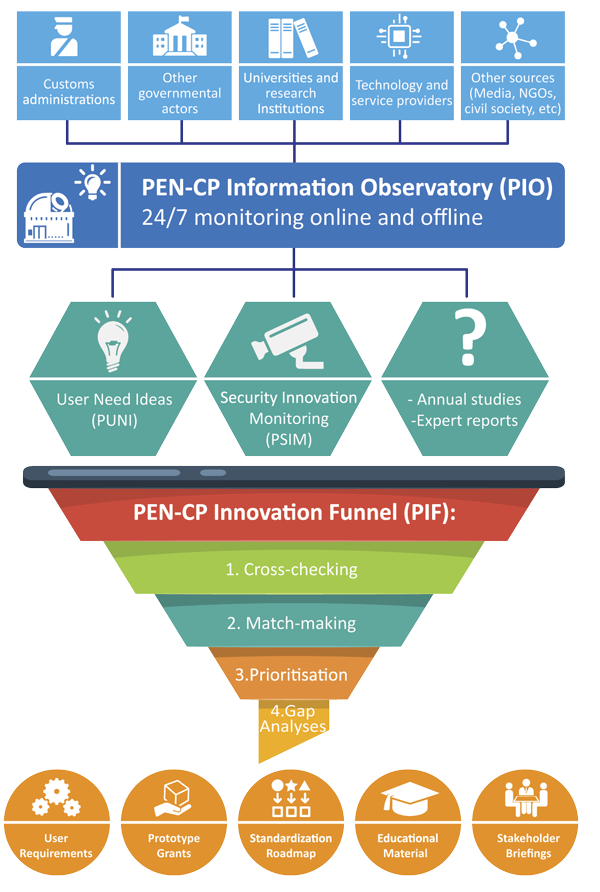The PEN-CP project boosts innovation and connects people knowledgeable in Customs and border security
22 February 2019
By Juha Hintsa, Senior Expert in Supply Chain Security and Trade Facilitation, Cross-border Research AssociationThe Pan-European Network of Customs Practitioners (PEN-CP) is a five-year project funded by the European Union (EU) under Horizon 2020 (H2020), the financial instrument implementing the Innovation Union, a Europe 2020 flagship initiative aimed at securing Europe’s global competitiveness. The PEN-CP’s overarching vision is to create an innovative networking system across Europe to translate security research, innovation ideas and requirements into scalable and viable solutions, technologies and process improvements that would help Customs administrations to overcome the challenges of contemporary Customs and border management security.
A total of 13 Customs administrations – Albania, Austria, Belgium, Estonia, Hungary, Ireland, Latvia, Lithuania, the Netherlands, Norway, Slovakia, North Macedonia and the United Kingdom (Home Office’s Border Force) – are direct beneficiaries of the project. Other project partners include the University of Lausanne (innovation funnel and dissemination material), the Technical University of Delft (innovation management), ARTTIC (an online platform), and the Cross-border Research Association (project coordinator).
Main activities
Instead of addressing a single Customs security challenge or problem, like it is done in most EU-funded H2020 research and development projects, PEN-CP participants carry out a broad range of small-scale activities aimed at monitoring and boosting innovation in six security related domains: risk management and “big data,” detection technologies, laboratory equipment, border performance measurement, Customs-police-border guard cooperation, and Customs-business partnerships. Let’s take a closer look at the four main activities carried out under the PEN-CP project:
- PEN-CP monitors and categorizes innovations and innovators, i.e. projects, products, prototypes, patents, companies, research institutions, university labs, etc., seeking innovative ideas, even from outside the Customs domain (e.g., the police or forensic services). The outcomes of the continuous online and offline monitoring are shared on the electronic PEN-CP platform, in an easy-to-use-and-search format. For example, a user can ask the system to “show all available products, patents and research papers on narcotics detection and verification equipment.” Regarding existing tools and technologies, Customs’ partners can share user experiences between one another. In other words, PEN-CP spreads security innovation news.
- PEN-CP collects and analyses ideas from administrations. Ideas can vary from preliminary, not-yet-well-defined versions to more mature, well-articulated ones, for example, in the context of detection technology performance, laboratory device accuracy, etc. All ideas are stored on the PEN-CP platform. Users can revisit their ideas, and add details. They can also promote and/or challenge other users’ ideas. Close cooperation with other expert teams created under the EU Customs 2020 programme – including the Customs Eastern and South-Eastern Land Border Expert Team, the Customs Laboratories European Network, and the Customs Detection Technology Project Group – is crucial. In other words, PEN-CP sheds light on emerging security needs.
- PEN-CP generates matches and analyses gaps between the security innovations and innovators vs. the security user need ideas of network participants. This process takes place in the so-called PEN-CP Innovation Funnel, or PIF, (see graphic illustration) where the prioritization of processed items also happens. In case there is a match between a user need idea and an existing security innovation, the system alerts PEN-CP participants. In other words, PEN-CP facilitates matchmaking between user needs and existing or upcoming solutions.
- When high priority ideas do not have a direct match with existing products and projects, participants can opt to develop tailored content such as user requirement specifications, prototype grant specifications, and standardization roadmap items or stakeholder briefings. In other words, PEN-CP contributes to the future of Customs security.
How it all works
At the heart of the PEN-CP project lies the so-called PEN-CP Innovation Funnel (see graphic illustration). The PEN-CP Information Observatory – moderated by the PEN-CP Management Team – at the top of the funnel monitors, in a continuous manner, a broad set of online and offline sources:
- Customs administrations inside and outside the PEN-CP consortium;
- Other governmental entities, such as political institutions, the police, border guards, and patent offices;
- Universities and research institutions;
- Technology and service providers, including those who have provided services and those who have not provided services to Customs;
- Ad hoc information sources, such as media and non-governmental organizations, among others.
The types of monitored information include product sheets, project websites, organization descriptions, research papers, conference papers, news items, and postings on social media, among others – again, all in the broad context of Customs and border security related technologies, services, and procedures.
The Observatory also identifies ideas expressed by users (PUNIs), as well as relevant organizations, projects, solutions and patents (PSIMs) calling for follow-up monitoring and review. In cases where additional information is required on a specific topic, the production of an expert report or an annual study chapter can be triggered.
Finally, following a well-defined cross-checking, match-making, prioritization and gap analysis protocol, the PEN-CP Innovation Funnel triggers the following ultimate outputs for the project: detailed user requirement documents, specifications for field trials/prototype grants, standardization roadmap items, content for educational material, and briefings on Customs and security research policy for decision-makers.
Graphic representation of the PEN-CP project
Cooperation mechanisms
Boosting innovation across the six themes addressed by the PEN-CP is highly relevant for the vast majority of Customs administrations across the globe. It would also be of interest to explore how PEN-CP participants and the WCO could cooperate. One possibility would be to share user experiences with promising technologies through the WCO News magazine or at WCO events, or by establishing, for example, a reporting mechanism, enabling innovations from around the world to be shared with the PEN-CP.
For questions, comments or suggestions on the PEN-CP, please feel free to contact any of the Project Management Team members: Mr. Jonathan Migeotte, Belgian Customs and Excise Administration; Dr. Dezsi Zsolt, Hungarian National Tax and Customs Administration; Mr. Kevin Humphreys, Ireland’s Office of the Revenue Commissioners; Mr. Trevor Francis, UK Border Force; and Dr. Juha Hintsa, Cross-border Research Association (PEN-CP Coordinator).
More information on PEN-CP
- Visit the website: pen-cp.net
- Follow on Twitter: @PENCP_NET
- Subscribe to the quarterly PEN-CP email newsletter: pen-cp@cross-border.org
- Watch the short PEN-CP video: https://youtu.be/OXwQPHHS5Ls
- Watch the long PEN-CP animation video: https://www.youtube.com/watch?v=wq9y36J4ET8
More information on the EU H2020 programme
Visit the website: https://ec.europa.eu/programmes/horizon2020/en


